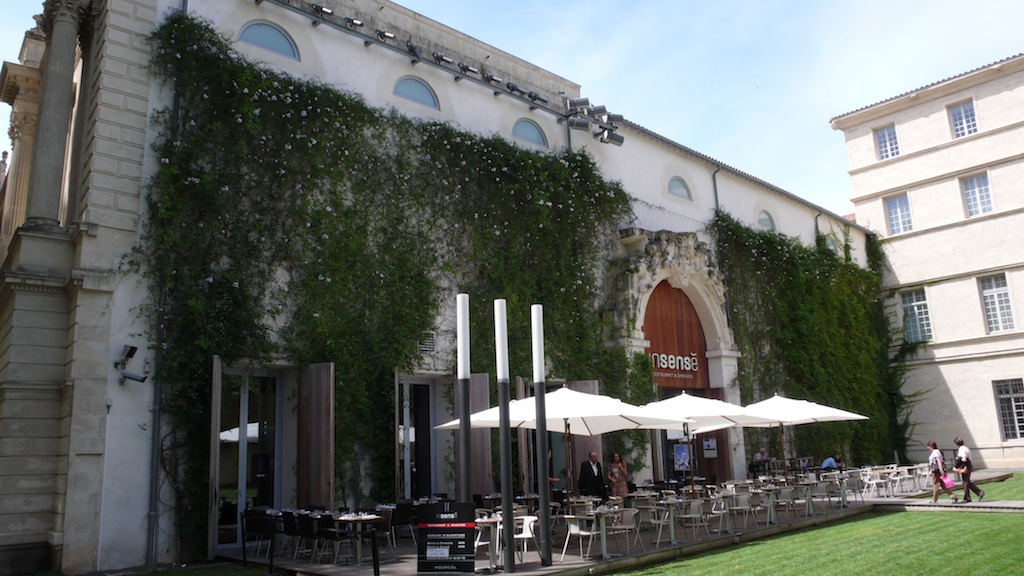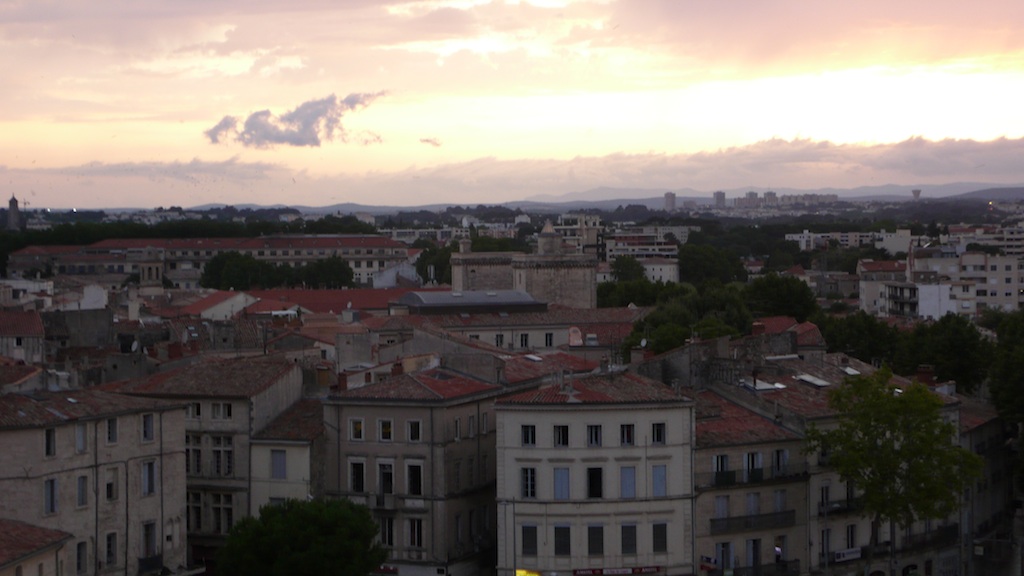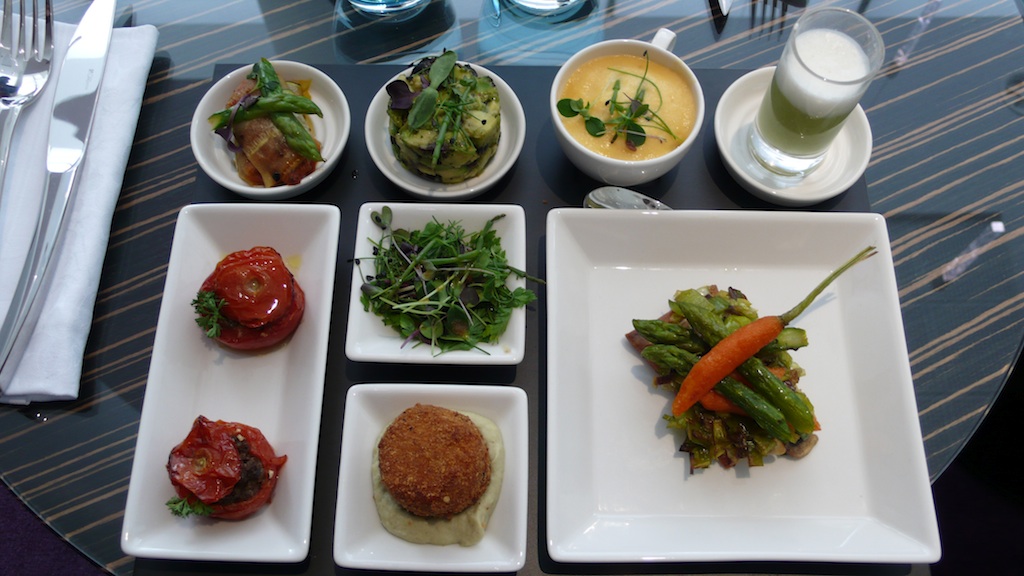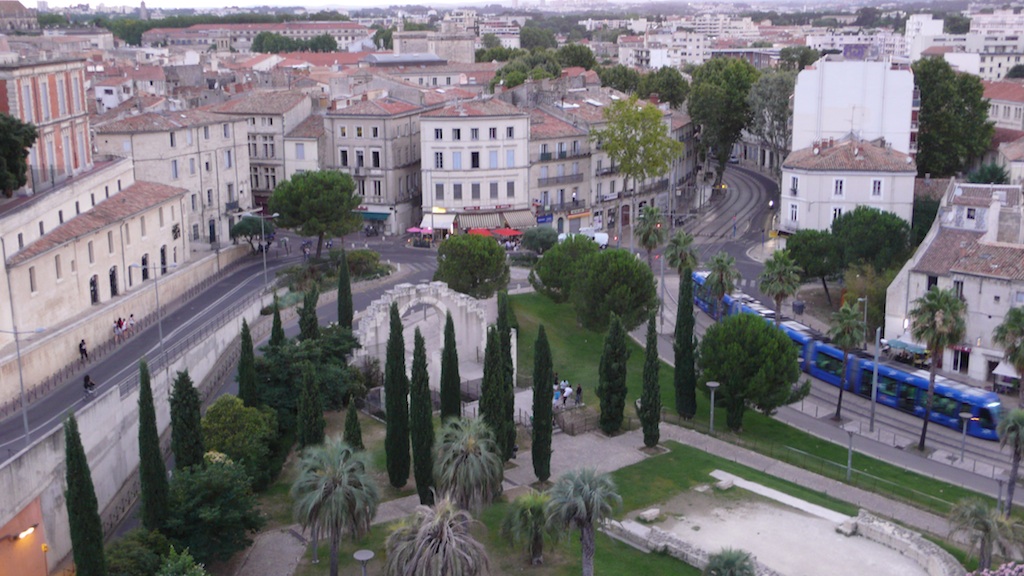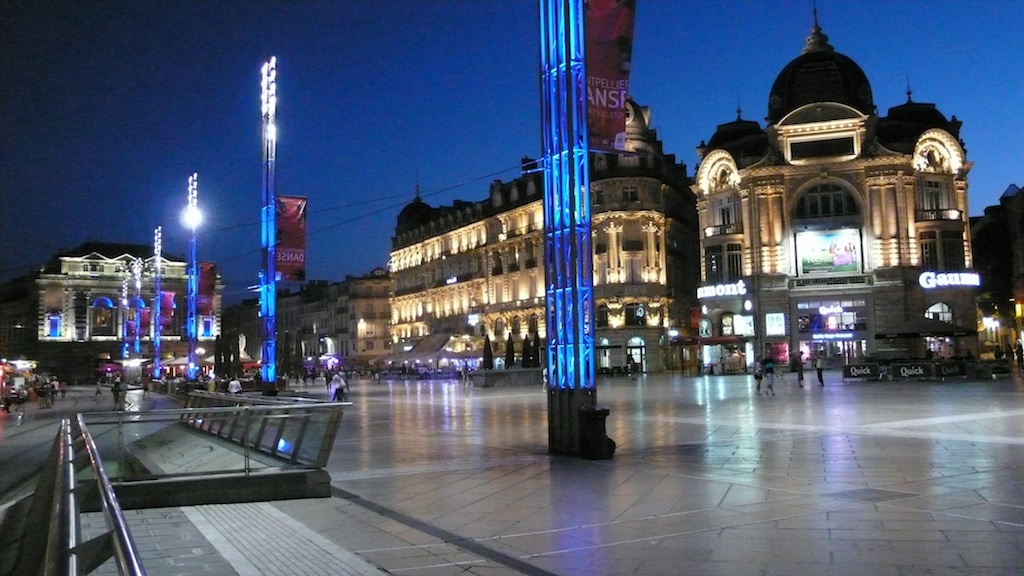Few things are as delicious as a ripe tomato eaten like an apple while lost on a bicycle on the way to the Mediterranean. Nearly thirty years before, we had traversed this road to the beach almost every day of the summer. Our skin as toasted as toffee, we used to hop on our moped and head to the beach where we’d linger until sunset. We could’ve walked that route blindfolded – so how could we be lost now?
As Thomas Wolfe knew, it’s sometimes difficult to return to a place that you once called home – and way back in the Eighties, Montpellier had been our home. For a year, we had conscientiously saved our money so that we could move to France and rent a small apartment near the Peyrou in Montpellier. It was the same apartment that one of us had rented eight years before as a student at the Université Paul-Valéry Montpellier – so that even then there’d been a sense of homecoming.
The landlord back then had been a Moroccan man with two college kids – and as luck would have it that year, the daughter’s boyfriend was attractive enough to merit our interest in the peephole in the wall between the two apartments (and particularly when their unleashed libidos produced an amatory chorus). A cat named Minou used to jump back and forth between the two apartment balconies, following the sun, sleeping on our desk by the window – until the day that she slipped and fell to the street below, whereupon the landlord’s daughter nursed her back to health with a stopper filled with milk and painkillers. At night, we drank wine and smoked: Marlboros and hash.
Montpellier in those days was a sleepy Mediterranean town – and particularly in the summer when many of the city’s students left town. Founded in 985 A.D., Montpellier has been a university town since 1180, when the oldest medical school in the western world was founded, as well as a school of law. And with more than 300 days of sun annually and a distance of ten kilometers from the sea, Montpellier in the summer could be very hot – which was why we often headed to the beach and why we were headed there again.
What we didn’t fully comprehend (apart from the difference between pedaling a bicycle to the beach and riding a gas-powered moped) was how much larger the city has grown in recent years. Back when we’d lived in Montpellier, the city was the 25th largest in France, with a population of less than 200,000. Nearly thirty years later, Montpellier, the fastest growing city in the country, has become France’s eighth-largest city, with nearly 40% of its population under 25. Today, nearly one in three residents of Montpellier is a student.
In short, the city had stayed young, while it was us who had aged, a fact of which we were acutely aware as we parked our bicycles in front of a local produce stand and wiped the sweat from our faces. We devoured the tomato with a baguette and then sucked down four fresh peaches, a liter of water, and two aloe vera drinks. Apparently, we were halfway to the sea – that is, if we turned back, turned around, and followed the signs.
Built on a hill in the Early Middle Ages, Montpellier was settled inland, due to pirate raids on other towns closer to the sea. The original two hamlets and chateau were surrounded by fortified walls – and the resultant shape of the city was similar to a shield or an escutcheon. Not long after we’d last visited Montpellier in the 1980s, the city had embarked on an innovative migration “back to the sea,” with massive developmental projects to the east of the city along the Lez River. The monumental Antigone project, a neo-classical district designed by Catalan architect, Ricardo Bofill, will soon be followed by Odysseum, a retail and leisure development in the new Port Marianne district. Poised on a lake, overlooking the Lez River, the new city hall, designed by Jean Nouvel, is scheduled to open at the end of 2011.
The result of all this urban development is that Montpellier has become a paragon of a medieval city complemented by contemporary architecture. With buildings by prize-winning architects such as Zaha Hadid, Richard Meier, Christian de Portzamparc, François Fontès, Bofill, and Nouvel, as well as a tram decorated by fashion designer Christian Lacroix, the city has become as notable for its visionary architecture as it is for the vaulted archways and medieval alleyways across which streetlamps hang. Montpellier’s “Ecusson” (or historic city center, so named for its resemblance to an escutcheon) is one of the largest pedestrian zones in all of Europe – and a major draw for the city’s five million annual tourists.
Back when we’d lived in Montpellier, hardly any of the locals had spoken English – and the French they’d spoken was with an accent that made the language sound nearly indecipherable to Parisians. The influx of French Algerians, resettling in France after Algerian independence, as well as the migration of Moroccans into southern France, had given Montpellier a polyglot culture befitting its medieval history as a trading center with its traditions of tolerance for Muslims, Jews, Cathars, and later, Protestants.
For much of the world in the 21st century, English has become the lingua franca for tourists – and nearly everyone of whom we asked directions to the sea in our rudimentary French answered us at least in part in English. And yet, still, we took the wrong turn and ended up at Palavas les Flots, a somewhat faded seaside town with a heap of Sixties architecture that has not stood the test of time.
What we were seeking was le Petit Travers, a section of the beach between two towns along the Mediterranean that is as notable for its dunes as for its beautiful beach and pristine water. Years before, we’d befriended a lovely French boy named Henri who lived on the beach, each night sleeping in a dune shack, ostensibly so that he could watch over the rental sailboats – that is, when he wasn’t entertaining us.
The year that we lived in Montpellier, there was one gay bar that required a knock on the door before a peephole opened, whereupon entry was granted. And there was also a large, bordello-red nightclub – very “Moulin Rouge” – that was Montpellier’s equivalent to Le Palace in Paris. Many gay boys cruised the Place Royale du Peyrou, the esplanade lined with allées of plane trees, which was built during the reign of Louis XIV – and conveniently located near our rental apartment and which, if truth be told, probably gave our neighbors reason to use the peephole from their side of the wall, should they have desired.
Today, the Peyrou is the site of Montpellier’s annual LGBT Pride celebration, one of several LGBT festivals, along with the annual International Gay and Lesbian Sports Tournament, which includes volleyball, swimming, and – get ready – badminton. Montpellier also has two opera houses – the 1,200-seat Opéra Comédie, built in 1888, and the 2,000-seat Opéra Berlioz, built in 1990 – which bookend the Place de la Comédie and the Esplanade Charles de Gaulle less than a quarter mile apart and serve as another example of Montpellier’s historic embrace of culture and knowledge.
It was dusk when we returned to the city from our journey to the sea. We took an apero at the Place de la Canourgue, near the School of Medicine, which is around the corner from the Jardin des Plantes, France’s oldest botanical garden, established in 1593. And then, in the gloaming, we wandered the city’s streets, in search of what had once been our apartment in the city.
Unlike our journey to the sea, our feet led us through the medieval alleyways as if we were sleepwalking and without speaking, we nodded at the bakery where we’d once purchased our daily baguettes and our morning croissants, and the tabac that we’d favored, and the tailor that we’d used whose storefront was now a trendy little restaurant – and then, around the corner, there were the windows to our third-floor apartment: the little balcony from which Minou had plunged and the window from which we’d thrown down the key whenever we’d had visitors.
We read the brass nameplate on the front door – and we were awestruck to see the same name as our landlord from thirty years before. We stood back to get a photo – and as we were focusing, a young woman came down the street. She looked at us and smiled and then, as unexpected as it was fated, she pulled a key from her pocket and opened the door that had once been ours.
Of course someone else lives there now, in the apartment that was once ours. And as we headed back to our hotel, all around us we saw students who were as young as we’d been once, and every bit as in love, and radiant from a day at the beach, and happy to be living, for the moment, in Montpellier. City of yesterday, city of tomorrow. If Paris is for lovers, Montpellier is for students of love.
WHAT TO SEE:
Musée Fabre: Flush with riches when the city was the capital of Languedoc during the reign of Louis XIV, Montpellier’s elite built magnificent private mansions (or “hôtels particuliers”) – and a number of those formerly private residences now house some of the city’s more prestigious museums.
Originally built as the Hôtel de Massillian, the Musée Fabre was opened in 1828 with a bequest from François-Xavier Fabre, one of Montpellier’s more altruistic aesthetes. Fabre’s generosity provoked similar bequests from no less than four other philanthropists whose erudite collections form the foundation of the museum’s holdings, which include works from Poussin, Jacques-Louis David, Veronese, Carracci, Brueghel, Rubens, Courbet, and Delacroix, as well as Impressionist works from Monet, Manet, and Renoir.
Themed tours of particular LGBT interest include “The Nude,” with its focus on Fabre’s erotically charged “La mort d’Abel” (1790), as well as his “Soldat Romain au repos” (1788), and Benouville’s “La Colère d’Achille” (1847), all three of which appear to be harbingers for Bruce Weber’s photographic work for Abercrombie & Fitch.
Radically and painstakingly renovated in 2007 at a cost of nearly $100 million, the new Musée Fabre includes a stunning modern addition that houses the collection of Pierre Soulages whose massive black canvases hang juxtaposed to translucent glass walls.
A second mansion, the Hôtel Cabrières-Sabatier d’Espeyran built in 1874 for the Count de Paul, was bequeathed to the Musée Fabre in 1967. Recently reopened, this historic residence includes a collection of over 1500 pieces of decorative arts and furnishings spread out over two floors of rooms arranged as they were lived in during the 19th century in the style of Napoléon III.
The sumptuously decorated rooms include works from celebrated cabinetmakers, and furnishings with such evocative names as “bonheur du jour,” which is a lady’s writing desk or secretary, and a “duchesse brisée,” a two- or three-part lady’s chaise longue. Fetch us a “duchesse brisée” right now; we feel the vapors coming on.
With collections like these, it’s hardly surprising to learn that Musée Fabre is the most visited museum in the south of France.
LINK: Musée Fabre
Chateau de Flaugergues: Some of Montpellier’s more splendid residences are its “folies,” a series of castles, country estates, and summer homes built in the “foliage” (hence the name) by the city’s elite during the 17th and 18th centuries. Created during a period of ostentation as signifiers of the owners’ wealth and social standing and their service to the King, these “folies” were often adorned with spacious parks and landscaped gardens.
Chateau de Flaugergues is Montpellier’s oldest “folie,” built in 1696 by Etienne de Flaugergues whose careful landscaping served as an example for numerous other regional “folies.” A family home, then and now, Chateau de Flaugergues is architecturally notable for its three-flight, suspended staircase that occupies nearly one third of the chateau’s total area. A rare example of a hanging key vault style of architecture, the staircase is a phenomenon with its forged iron banisters and decorative balusters – and its position in the center of the chateau.
Outside, the chateau’s parks and gardens encompass nearly ten acres and include a terraced French flowerbed, a botanical garden, an olive tree allée, an English garden, and a vineyard.
If you are fortunate enough to be offered a tour of the property by the chateau’s owner, the Count Henri de Colbert, then you will be given a fascinating window into French life as lived during the reign of kings. Follow his lead into the wine cellar – and toast to the good life in France.
LINK: Chateau de Flaugergues
“Brassai en Amerique” @ Pavillon Populaire: One of the most definitive photographers of Paris, Brassai was born in Transylvania – but it was in Montparnasse, during the golden age of Moulin Rouge, that Brassai was born as an artist. “Paris de Nuit” was published in 1932, whereupon the photographer became inextricably linked with Paris and its colony of bohemian artists.
In 1957, the American magazine “Holiday” invited Brassai to New York and New Orleans – and the exhibition currently at Montpellier’s Pavillon Populaire, “Brassai en Amerique,” shows the exuberance with which Brassai photographed America for the first time. Never before published, Brassai’s photographs of America are a revelation of saturated color and carefree youth – and his depictions of these two iconic American cities and their citizenry is imbued with a bittersweet sense of innocence lost. Exhibition runs through 30 October 2011 .
LINK:“Brassai en Amerique” @ Pavillon Populaire
WHERE TO EAT:
Husser, Brasserie le Corum: Montpellier’s cultural spinal column commences with the Opéra Comédie on the Place de la Comédie and then traverses along the Esplanade (home to Musée Fabre), all the way to the Corum, the 1988 pink marble building where the second of Montpellier’s two opera houses is located.
Apart from the Opéra Berlioz, the Corum is home to Husser, a modern brasserie under the direction of wunderkind chef Frédéric Husser, who specializes in Mediterranean cuisine with a contemporary flair accompanied by exemplary regional wines.
The Corum is the permanent home of Montpellier’s National Orchestra, as well as the locale for many of the performances of the Montpellier Danse International Festival – and Husser is perfectly situated for both pre- and post-performance meals and cocktails. One night, we dined on festively fresh salads and frites before heading upstairs to the opera house – and then returned for desserts that were the culinary equivalent of Fauvist paintings.
Designed with eye-popping Provençal colors that would make Christian Lacroix smile, Husser serves food that is as theatrical as it is delicious.
LINK: Husser, Brasserie le Corum
Ristorante Pizzeria Sicilia: For more than thirty years, at the base of rue Pila St. Gely, Ristorante Pizzeria Sicilia has been serving what might well be the best Sicilian pizza in the south of France.
Located at the base of rue Pila St. Gely, a medieval street with a number of restaurants, Sicilia is a family-run restaurant (of course), serving a pie with a perfectly-charred and chewy crust and a sauce that takes advantage of the region’s bountiful produce. The Marinara, with nothing but garlic, tomatoes, and olive oil is a reminder that in the summer, in the south, simple is the best – and the most delicious.
Nearly as good as the pies is the professionalism of the staff who seem to anticipate your every need before you do – and who, at meal’s end, pour your table a round of limoncello. This is hospitality, Sicilia style.
To eat al fresco at Sicilia on a seasonal evening in the glow of streetlamps hung across the medieval alleyway is to sink into a Mediterranean reverie about “la dolce vita” – and to realize that you’re living it.
LINK: Ristorante Pizzeria Sicilia
Folia, at Chateau de Flaugergues: If you are fortunate enough to find yourself on the grounds of Chateau de Flaugergues on a summer’s day, dining at Folia in a courtyard of the chateau and drinking wine from the chateau’s vineyards, then you will understand why the French believe they discovered “joie de vivre.”
Folia’s chef, Thierry Alix, utilizes regional produce from the local markets to create a seasonal menu that complements the chateau’s wines. The restaurant’s interior spaces are an amalgam of clean lines and sleek finishes juxtaposed with the original stonework of the castle’s foundations.
A short bike ride from Montpellier’s medieval city center, Folia, at Chateau de Flaugergues, provides you with an opportunity to imagine yourself as a weekend guest at the country estate of 17th-century royals. Sink into your chair and toast to the monarchy that made way for you.
LINK: Folia, at Chateau de Flaugergues
Le Carré: In the heart of the Ecusson, the city’s historic center, in one of those charming little medieval European squares that draws both tourists and locals night after night, there’s a sweet little restaurant called Le Carré (the Square). The menu is both inventive and regional, with entrees such as beignets de pomme de terre and carpaccio de St. Jacques – and a stunning dessert sampler called Kfé Gourmand, which features chocolate, caramel, and espresso in several blissful incarnations. We’re salivating still.
LINK: Le Carré
WHERE TO STAY:
Crowne Plaza Montpellier Corum: A brand-new, four-star property perfectly located alongside Montpellier’s second opera house, Opéra Berlioz, the Crowne Plaza is a sleek addition to the city’s collection of noteworthy modern architecture. Each of the hotel’s four floors is dedicated to a different continent and designed accordingly, with dark woods and sumptuous fabrics.
The hotel’s 142 rooms (and four suites) feature floor-to-ceiling windows, which provide generous sunlight while making the well-proportioned rooms feel even larger. Bathroom ceramics are by Villeroy & Boch Since 1748, with toiletries by Pascal Morabito Paris.
The pool with its outdoor solarium and bar is a serene urban oasis with a resort sensibility – and a perfect locale for working on your iPad, thanks to free WiFi throughout the hotel.
As this is something of a business person’s hotel, the hotel’s breakfast buffet is somewhat overpriced (think expense accounts) – but the staff could not be more accommodating and amiable.
Within easy walking distance to the Ecusson, the city’s historic center, the Crowne Plaza Montpellier serves as a testament to Montpellier’s focus on the future – and from this vantage point, the future looks very bright.
LINK: Crowne Plaza Montpellier Corum
GETTING THERE:
Air France: Even when flying economy, Air France makes a transatlantic flight seem more like a luxury than drudgery, thanks in part to their fleet of Airbus 380-800 (and Charles Lafitte 1834 Champagne…).
Since 2007, the Airbus 380 has generated raves from passengers, regardless of what class they’re flying – and Air France creates an atmosphere that is as elevating as the vintage wines they serve. Two-course dinners are nearly as tasty as the descriptions on the menus – and the demi-bottles of wines are perfect accompaniments to chocolates and cheeses. Blankets and pillows are clean and fresh – and the multi-lingual staff is as polished and professional as a Chanel suit. You might imagine feeling cramped on a plane with this capacity, but the A380-800 recycles air every three minutes – and there are four high-level air outlets (rather than the industry standard of two).
In short, this is one smooth flight – and a reminder of why France has always been at the forefront of aviation technology.
LINK: Air France
Rail Europe: One of the glories of Europe is its rail system, which, in most EU countries, runs as smoothly as a Swiss watch. France’s TGV (Train à Grande Vitesse, meaning “train of high speed”) is a particular delight – and to ride on the upper level while staring out at the passing vineyards is to feel an immediate kinship with the many expatriates who’ve chosen to make Europe their home.
Recently, Rail Europe announced an LGBT promotion in four gay-friendly countries – Switzerland, Germany, Denmark, and the Netherlands – that enables you to save 10% when you journey beyond fabulous France.
LINK: Rail Europe
ADDITIONAL TOURISM INFO:
Click here for MRNY slideshow of Montpellier in summer
Click below for: Gay Montpellier Montpellier Tourism LOM, southern France gay magazine Gay France / France Guide French Tourism / France Guide




